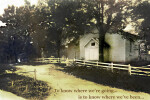A History of Union Chapel, Part 1: 1822 - 1897

Union Chapel is moving into the future. And, to appreciate where we are going, it is helpful to understand where we have been.
No story of Union Chapel Church can be separated from Union Chapel Cemetery. In 1822, Jacob and Elizabeth Whitinger began clearing land in north-central Marion County, on the west bank of the White River. Elizabeth died in August of that year and was buried on a bluff overlooking the river. In September, Jacob purchased the land they had claimed, which included the location of her grave -- known as the "Whitinger Burial Ground." In 1839, he made a grant of about 18 acres of this land for "public burial and divine, nondenominational worship."
By 1860, timber had been removed from the surrounding lands and the towns of Nora and Allsionville had been founded. There was no official church in Nora, although there were several in surrounding towns. The Methodist Episcopal Church used Circuit Riders, and it is believed that they would stop at Nora when in the area, probably meeting with the worshippers in the schoolhouse. In 1857, Union Chapel was mentioned in the records of the Allsionville Circuit of the Methodist Episcopal Church, though not as a regular member. It seems that the local custom was that whenever a minister of any denomination came into the Nora community, he had a place to preach, regardless of his denominational ties.
In 1857, Union Chapel was mentioned in the records of the Allsionville Circuit of the Methodist Episcopal Church, though not as a regular member. It seems that the local custom was that whenever a minister of any denomination came into the Nora community, he had a place to preach, regardless of his denominational ties.
In early 1864, residents in the area met to lay plans to erect a church building on the grounds of the cemetery. A building campaign raised the needed money, and the men of the neighborhood gave the timber and time to help build the church. The name UNION CHAPEL was chosen since Mr. Whitinger had stipulated that services were to be interdenominational. Services in the new building began in the fall of 1864.
The original minister for that new building was Methodist Episcopal, but in following years the church was also served by a Friends pastor from Carmel, a minister from the Christian Church, and a Lutheran. In 1897 the Lutheran pastor announced that he was organizing an official congregation in the location, but canceled the organizational meeting with an announcement that he had accepted a call to another parish. Then, a local Methodist Episcopal circuit rider stepped into the void. Within a month, he had preached his first sermon and extended an invitation for persons to join the Methodist Episcopal Church. Two couples did.
(Continued next week.)

Comments
Login/Register to leave a comment